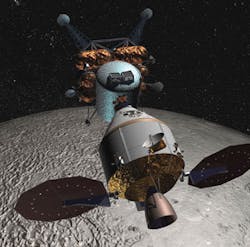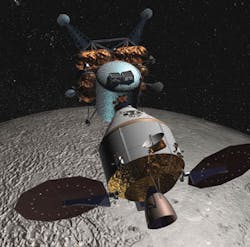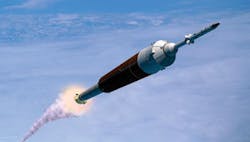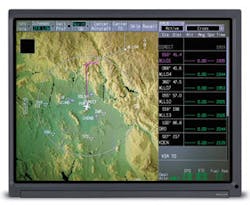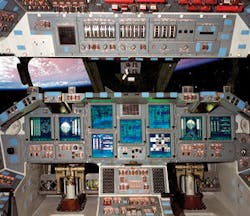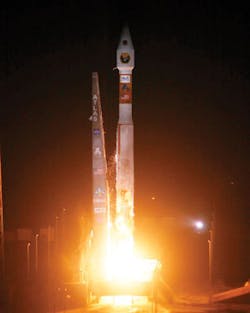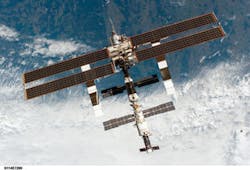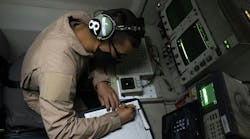Designers of Orion, the next manned space vehicle from NASA that will service the International Space Station and return man to the moon, are using open-architecture designs for the avionics and crew cockpit.
By John McHale
Nearly 40 years ago phrases like flying tin can or flying washing machine sometimes were used described NASA’s first lunar missions. However, when human pilots begin their next journey to the moon they will be navigating from a cockpit not far different from today’s commercial jets and in a spacecraft reminiscent of fictional starships.
NASA’s Orion Crew Exploration Vehicle will be able to transport four crewmembers for lunar missions and later supporting crew transfers for Mars missions. Orion also could carry as many as six crew members to and from the International Space Station.
The first Orion launch with humans onboard is planned for no later than 2014, and for a human moon landing no later than 2020. NASA leaders say Orion will form a key element of extending a sustained human presence beyond low-Earth orbit.
Honeywell is already designing the cockpit’s avionics leveraging as much proven commercial technology as possible for the space mission. “NASA’s statement of work to Lockheed Martin-the Orion Prime contractor-and Lockheed’s statement of work to us requires an open architecture to help with technology refresh,” says Ray Crum, technical director of the Orion program at Honeywell’s Human Space Group, which is part of Honeywell’s aerospace business in Phoenix.
Planning for technology refresh to combat obsolescence is a key aspect of the Orion avionics design. The shuttle program flew for decades with technology from the 1970s until upgrades to cockpits a few years ago. The shuttle avionics were as much as five or six generations behind current standards.
The Orion program will be designed with an open architecture from the ground up to better manage obsolescence and provide the aircraft with advanced technology as quickly as environmental testing for space will allow.
The Orion program is split into two blocks. Block 1 will be for servicing the International Space Station (ISS) and Block 2 will be the lunar module, Crum says. The team has not decided yet whether to design both blocks together or the Block 1 first then upgrade for Block 4, he adds.
COTS usage
There is no requirement from NASA on how much commercial-off-the-shelf (COTS) technology is to be used for the avionics, Crum says. However, he notes that COTS hardware and software will be used wherever it fits.
The command computer will use a COTS PowerPC 750 FX processor, which has performed well in radiation testing, Crum says. Honeywell will do further testing but it does look promising, he adds.
The software operating system is also a COTS product-the Green Hills Integrity DO-178 real-time operating system (RTOS) with ARINC 653 partitioning. The software is deployed on the Boeing 787 flight-control system and is being leveraged for Orion, Crum says.
The ARINC 653 partitioning is a key integrated-modular-avionics (IMA) tool-especially when it comes to technology refresh, Crum says. It makes a difference because it saves time and money when upgrading. In other words, when the display system in the cockpit needs to be upgraded only the code related to that function will have to be recertified, Crum says.
Integrity-178B is an ARINC-653-1-compliant, securely partitioned real-time operating system that targets demanding safety-critical applications containing multiple programs with different levels of safety criticality, all executing on a single processor, Green Hills officials say. Integrity-178B has been engineered from the ground up to provide security and determinism.
The RTOS offers a universal run-time environment able to execute a variety of avionics and flight-control tasks at different safety and security levels. Integrity-178B’s ARINC-653-1-Application/EXecutive (APEX) interface provides a recognized standard interface between the operating system of an avionics computer resource (ACR) and the application software. Its ability to support ARINC-653-1 while complying with DO-178B Level A provides a COTS baseline avionics operating environment that meets standards already adopted and accepted by the commercial avionics industry for IMA, Green Hills officials say.
Without partitioning the RTOS, “we would have to recertify everything,” which would take up a lot of man-hours, he explains. “The ARINC 653 partitioning gives us a lot of flexibility with the software.”
The Orion avionics will contain about a million lines of code, so flexibility when it comes to certification will be essential, Crum says.
Displays
The displays for the Orion cockpit will also leverage commercial technology. The units will be very similar to the cockpit displays and graphics in the Boeing 737 upgrade, Crum says.
Honeywell provided similar technology for the upgrade of the space shuttle displays with their Multifunction Electronic Display Subsystem (MEDS), which swapped out the old shuttle cockpit’s mechanical and analog instruments and cathode-ray-tube displays and replaced them with software-driven multifunction liquid-crystal displays (LCDs).
The Orion display functionality will be a solution of less equals more-less displays but more functionality.
The MEDS upgrade to the space-shuttle fleet had nine different units while the Orion cockpit will only have three or four, Crum says. The MEDS units were about eight by eight inches while the Orion units will be approximately 10 by 13 inches, give or take, Crum says.
The displays will be for the commander and the Orion pilot. The units will be able to split the window and show several views displaying all pertinent information thereby easing the decision-making process and cutting down on human error.
The displays will be based on Honeywell’s DU 1310 units, which have high-definition color and a wide viewing angle. The DU 1310 is a 14.1-inch display unit that integrates with the Primus Epic integrated avionics system to provide versatile display solutions for any aircraft. Integrated navigation (I-NAV) and surveillance provided by the DU1310 with the Primus Epic system gives the operator situational awareness.
“We’ve utilized DU13-10 on all of our commercial and regional jets,” Crum says. “It’s a larger-form LCD we leveraged from commercial division that will be ruggedized for space.”
Situational awareness is a big part of the Orion cockpit, Crum says. Situational awareness is not just limited to avionics and graphics but human factors as well, which is why astronauts are working with the engineering teams at Lockheed Martin in Littleton, Colo., and Honeywell to design the new cockpit, Crum says.
Honeywell will also deliver command-display trainers each year so the astronauts can train on the real thing, he adds.
Crum could not mention what other technologies or display manufacturers would be chosen, as it is early in the process and evaluation of technology is ongoing.
Ruggedizing for space
Ruggedizing the electronics will be on a case-by-case basis depending on the inherent radiation resistance of each part, Crum says. Honeywell engineers look at each electronics part and see whether it needs radiation and other environmental ruggedization, and then perform the necessary vacuum, vibration testing, and so on, he adds.
Total dose and single-event-upset (SEU) testing will be done as well, Crum says. Electronics will be qualified at the box level and the vehicle level, he adds.
Yes, Crum says, it takes longer to qualify parts for space applications, but as long as that time is planned for, it is manageable.
The first Block 1 human flight is scheduled for between 2013 and 2014, with Honeywell set to deliver its first nonflight units by early 2010 with flight-ready units by late 2010 or early 2011, Crum says.
Ares I
Honeywell officials also announced that Honeywell would lead an industry team in pursuit of a contract to support NASA with design, development, and production of instrument-unit avionics on the new Ares I Crew Launch Vehicle. Ares I will transport the Orion Crew Exploration Vehicle into orbit.
Honeywell will spearhead the team as the prime contractor, with systems integration support from Lockheed Martin.
The avionics on the Ares I instrument unit will include an onboard computing system, flight controls to guide the launch vehicle into orbit, communications equipment, and inertial measurement units and rate gyro units for navigation. NASA plans to release a request for proposal for the instrument unit this month. A contract award is expected around December.
Boeing Orbital Express conducts first autonomous spacecraft-to-spacecraft fluid and component transfer
In its first on-orbit demonstration 300 miles above Earth, Boeing’s Orbital Express system autonomously transferred propellant fuel and a battery from one spacecraft to another.
During the fuel-transfer demonstration, the Boeing Autonomous Space Transport Robotic Operations (ASTRO) servicing spacecraft successfully transferred hydrazine propellant with Ball Aerospace’s NextSat, a prototypical modular next-generation serviceable client spacecraft.
The ASTRO vehicle also used a robotic arm to transfer a battery to NextSat. It marked the first time that a spacecraft autonomously transferred hardware to another spacecraft using a robotic arm, Boeing officials say.
The tests are the first in a series of planned demonstrations during a three-month mission to validate the system’s functionality.
“The Orbital Express team is accomplishing things that have never been done before in space,” says George Muellner, president of Boeing Advanced Systems. “These achievements are the first steps toward developing a system that will extend the life and operation of various types of spacecraft.”
Orbital Express, launched to orbit on a United Launch Alliance Atlas V rocket on March 8, is a Defense Advanced Research Projects Agency (DARPA)-led effort consisting of the Boeing ASTRO servicing spacecraft and the NextSat serviceable client spacecraft.
Through predemonstration system checks, the team verified the spacecraft’s ability to stay connected and hold a firm seal during transfer operations.
The team also performed an autonomous transfer of hardware between the two spacecraft. Using its robotic manipulator arm, ASTRO placed a battery on NextSat. The battery was successfully integrated into NextSat’s power system following the transfer.
The demonstrations occurred at the lowest levels of spacecraft autonomy, which required several ground-based “approval to proceed” (ATP) confirmations. The team initiated ATPs to closely monitor and evaluate the operations. Future demonstrations will require fewer ATPs, allowing Orbital Express to conduct flight activities with increased autonomy. At the highest autonomy levels, no ATPs are required.
Avionics for the Orbital Express System included devices from Aitech Defense Systems in Chatsworth, Calif. Aitech provided the first-generation computers for ASTRO that included several types of Aitech’s space-qualified, radiation-tolerant 3U CompactPCI boards.
“This launch and other successful programs, help strengthen the usefulness of embedded computing components in space applications,” says Roger Rowe, chief executive officer of Aitech.
The ASTRO computers (AC-1, AC-2, and AC-3) are integrated as three subsystems and are based on Aitech’s new, 3U CompactPCI-based product line including the PowerPC-based 3U S950 single-board computer, various analog and digital I/O boards, as well as a subsystem enclosure and power supplies.
The three mission-critical computers utilize Aitech’s space-rated boards and enclosures. The computers include the command and data-handling spacecraft control computer, the robotic-docking computer, and the replaceable avionics-insertion computer that will dock ASTRO with NextSat.
In the same United Launch Alliance Atlas V launch vehicle containing four additional experimental (microsatellite) spacecraft, Aitech also successfully deployed the space-rated S210 VMEbus SBC for the U.S. Air Force STP-Sat1 satellite.
Orbital Express team members include NASA, Ball Aerospace, Northrop Grumman Space Technology, MacDonald, Dettwiler and Associates Ltd., the Charles Stark Draper Laboratory Inc., and Starsys Research.
NASA modifies contract for Orion crew exploration vehicle
NASA officials in Washington have modified the agency’s contract with Lockheed Martin Corp. of Littleton, Colo., to design, test, and build the Orion crew exploration vehicle.
The updated contract contains three significant changes. Two years have been added to the design phase, two test flights of Orion’s launch-abort system have been added, and production of a pressurized cargo carrier for the International Space Station has been deleted from the initial design phase.
A fourth element of the contract modification provides for use of surplus raw materials, such as aluminum-lithium ingots now used in the construction of space-shuttle fuel tanks, for Orion. NASA officials say this will help ensure a smooth transition from the space-shuttle program to the Constellation program.
“NASA and Lockheed have been working together as a team during the past six months to iron out many critical design and schedule details,” says Skip Hatfield, manager of the Orion Project at NASA’s Johnson Space Center in Houston. “This contract update will synchronize our spending plan with the rest of the Constellation Program.”
NASA awarded the Orion prime contract to Lockheed Martin Corp. on Aug. 31, 2006. At that time, the development portion of the contract was valued at $3.9 billion with a period of performance through December 2011. This contract modification, in the amount of $385 million, brings the total value to approximately $4.3 billion and adjusts the development period of performance through December 2013.
This update is the result of a NASA request for engineering change proposal issued on Dec. 15, 2006. Lockheed Martin’s proposal was received March 7, 2007. The contract modification was signed April 20.
The modification reflects continuing progress on Orion’s development, including program formulation and systems assessments addressing the rocket, ground infrastructure, and all other elements necessary for a successful first launch. The period of performance now matches the evolving NASA budget landscape.
“The Orion team has made some critical decisions that will maximize the performance and flexibility of this spacecraft,” says Jeff Hanley, manager of the Constellation Program at Johnson. “This spacecraft will be a cornerstone of America’s human exploration of the solar system by a new generation of explorers, and these changes and additional tests will ensure that it is robust enough to accomplish its missions.”
NASA and Lockheed Martin have completed Orion’s systems requirements review and are moving toward a systems design review scheduled in August. For information about NASA’s Constellation Program and Orion Project, visit www.nasa.gov/constellation.
Quantum3D synthetic vision used for Orion avionics development
Designers at Quantum3D in San Jose, Calif., are deploying their synthetic vision technology to help develop the avionics for NASA’s Orion Crew Exploration Vehicle, the successor to the space shuttle.
Honeywell experts in Phoenix are using Quantum’s IData embedded graphical engine development tool to design digital display screens for the Orion cockpit, says Mark Snyder, director of embedded software engineering at Quantum3D. One example is a synthetic IData-generated docking imagery for use when docking with the International Space Station (ISS).
The docking procedures are mostly automated but this system is needed for crew training crew in case they need to dock the spacecraft themselves, Snyder says.
The IData tools can be used for several modes such as simulation for crew training and simulating for avionics development, Snyder says.
The IData application development toolset and cross-platform graphical application engine enables developers to create embedded graphics applications in a tool-driven environment, utilizing model-based development techniques, moving seamlessly between prototype/simulation environments and deployed systems without time-consuming code generation and compilation.
IData can simulate avionics systems so designers can test certain parts of a system, see what works and what does not then swap parts in an out based on how they perform in the simulation, he explains.
IData is suited for digital and analog instrumentation, flat-panel-display symbology, head-up displays, interactive virtual consoles, digital-map displays, and embedded training. The development environment increases fidelity and shortens development time for embedded cockpit displays, flight simulators, and aircraft trainers. IData also supports OpenGL, moving maps, integrated 3-D, video overlay, cursor control, and synthetic vision.
Quantum3D also looks to manage expectations with its IData product, Snyder says. The graphics capability and modeling capability of IData is enhanced when running on a commercial graphics processor, but those processors will not be in a spacecraft due to the environmental constraints. Therefore this IData application was engineered so it only uses the functionality that would be possible with a processor qualified for space environments, he explains.
“The key is making the software independent of the hardware,” Snyder says.
Another use of IData is to develop a model-based health and monitoring system, Snyder continues. For code generation of applications such as terrain mapping the process can be automated though embedded modeling, Snyder says.
This will automatically generate the code based on actual models for how software functions in different applications such as a display system, thereby cutting down on the amount of reverifying and recertifying code each time changes are made, he explains.
“Software has a tendency to become rigid” as you perform certification after certification. The model-based approach will be more flexible software in the long-term, he adds.
For more information on Quantum3D, visit www.quantum3d.com.
International Space Station to grow faster, mark firsts throughout year
Already spanning an acre in orbit, the International Space Station this year will grow faster in size, power, volume, and mass than ever before, significantly expanding its capabilities and setting new records for humans in orbit, NASA officials say.
“This will be a challenging but rewarding year for the station program,” says Kirk Shireman, deputy program manager for the International Space Station. “The station’s operations will grow both in orbit and on Earth. As we launch new international components this year, we also will begin new flight- control operations from facilities around the world.”
In addition to control centers in the United States, Russia, and Canada, control centers for the station also will be activated in France, Germany, and Japan, enabling NASA’s partners to oversee their contributions to the station.
In 2007, NASA and Russia plan to conduct as many as 24 spacewalks, more than has ever been done in a single year.
Also this year, the electricity generated and used on the station will more than double. By the end of 2007, the station’s solar panels will extend to almost three-quarters of an acre of surface area. The extra power and cooling will allow the station’s living and working space to expand by more than one-third. The complex will grow from its current size of a two-bedroom apartment to the size of a four-bedroom house by year’s end, NASA officials say.
The laboratories aboard will triple, with the addition of the European Space Agency’s Columbus lab and the Japanese Experiment Module Kibo. A shuttle mission targeted for October will deliver Columbus, while another mission targeted for December will carry Kibo. The additions will mark the first time the station’s interior space has grown in more than six years.
The station’s supply lines will also grow. A new European cargo vehicle, called the Automated Transfer Vehicle, is set to make its first trip to the station in July. Currently, only the space shuttle and Russian Progress cargo craft deliver supplies to the orbiting laboratory.
Robotic operations will also expand this year, NASA officials say. For the first time, the station’s robotic arm will be used to assemble large, pressurized components without a shuttle present. In the fall, the Canadarm2 will be used to move mating adapters and a large connecting module, called Node 2, into place on the station. Node 2 will provide pathways for crewmembers, air, electricity, and water to the new international laboratories.
As the station breaks new ground in its use of robotics, its robotics system also will grow. On the same mission that delivers the first section of the Japan Aerospace Exploration Agency’s Kibo lab, the Canadian Space Agency’s Dextre robotic system will be delivered. Dextre, an almost human-shaped two-armed robotic system designed to work with Canadarm2, will add to the highly sophisticated robotics aboard the space station. Dextre will enable the robotics to perform even more intricate maintenance and servicing tasks, which previously would have required spacewalks, NASA officials say.
For information about the International Space Station, visit: www.nasa.gov/station.
